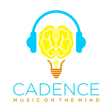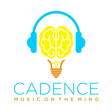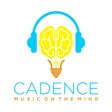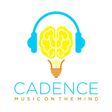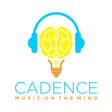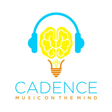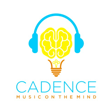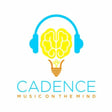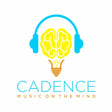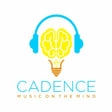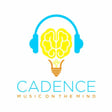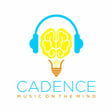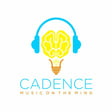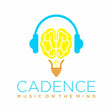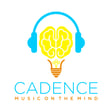Become a Creator today!Start creating today - Share your story with the world!
Start for free
00:00:00
00:00:01

S02 Episode 08: Music to Remember
In this final episode of season 2, we look at the dramatic effects music can have on patients with dementia—in some cases, it can bring back people who seem to be almost completely lost.
Transcript
The Emotional Impact of Music
00:00:08
Speaker
every single time I come in. Hi, we're gonna listen to music today. Oh, good. And like something like the last, I think the last time I went, she just wanted to talk the last time. But she, she loves those things. Especially if I put on bicycle built for two, that's, that's her favorite song that's into that. And you want my sunshine shoe. What is this? And then like her face just lights up.
Introduction to Cadence Podcast
00:00:37
Speaker
Welcome back to Cadence, the podcast where we explore what music can tell us about the mind. I'm Andre Viscontes. This is the last episode of our second season, where we've been telling the stories of people whose lives have been immeasurably improved by music. And we've been asking the question, can music be medicine? We'll be taking a break for a little while to work on season three, which will continue our exploration of the connection between music and our minds.
Music and Dementia: Alive Inside
00:01:17
Speaker
I wanted to cap off this season with a show about something that has a lot of personal meaning for me, for many reasons actually. Some of you might have seen the documentary Alive Inside about how bringing music to patients with dementia that they loved when they were younger seems to make them come alive again. Here's a clip from the film featuring the late neurologist Oliver Sacks and the patient Henry.
00:01:41
Speaker
We first see Henry, inert, maybe depressed, unresponsive, and almost unalive. Then he is given an iPod containing, we know, his favorite music.
00:02:02
Speaker
And immediately he lights up, his face assumes expression, his eyes open wide, he starts to sing and to rock and to move his arms, and he's being animated by the music. He's being brought to life.
00:02:18
Speaker
It's a remarkable story, and the movie shows the dramatic effects that music can have on people who seem to be completely lost.
Music Therapy and Creativity in Neurodegeneration
00:02:25
Speaker
I watched my own grandmother fade away as neurodegeneration robbed her of her memories, her ability to read and write, and eventually to make sense of the world.
00:02:34
Speaker
I wish I had known back then what a difference music might have made to our interactions, but I didn't. It wasn't until she was gone that I had the chance to work with my mentor and friend, the late neurologist and author, Oliver Sacks, on a couple of patients with dementia whose language abilities were impaired but for whom music was a bomb.
00:02:54
Speaker
At the time, I was doing a postdoc at UCSF's Memory and Aging Center under the direction of Bruce Miller, and we were trying to understand something kind of bizarre. In some patients, in the setting of neurodegenerative diseases, they develop a kind of creativity that they didn't have before.
00:03:14
Speaker
We call this paradoxical facilitation because the brain is deteriorating and yet something wonderful is coming out of it. If any of you are fans of Oliver Sacks, you can imagine why he was so interested in this work. As for him, every brain is not just an organ that deserves to be studied, it's a human being. And that when people's brains are changing, that doesn't necessarily mean it's all for the worse.
00:03:41
Speaker
But why do some patients, when their minds begin to degenerate significantly, turn to these artistic pursuits? I mean, sometimes they create art that is far more interesting and even acclaimed than what they were able to produce before their disease began to rob them of many of their cognitive abilities.
Artistic Expression in Neurodegenerative Conditions
00:03:59
Speaker
For example, patients with aphasia, which is a language problem, often become more interested in the visual world when their ability to communicate using speech is affected. I like to think about the difference between the front and the back of the brain. If you think about the front of the brain as being primarily
00:04:17
Speaker
where language is located for most people, where our executive function is, where sort of our higher cognitive skills reside. The back of the brain is more about sensation and perception. That's where our visual cortex is, where a lot of our senses are, where we integrate our senses and so forth.
00:04:35
Speaker
So in some of these patients, the degeneration begins at the front of the brain and leaves the back of the brain spared. And in these patients, sometimes they become much more interested in the visual world. In fact, in one of my studies, I found that patients with a type of aphasia, or a type of language problem called semantic dementia,
00:04:55
Speaker
which robs them of conceptual knowledge. So, for example, they first can't tell the difference between a robin and a sparrow, and then eventually they can't tell the difference between a small bird and an eagle. Eventually, all birds are just animals, and their entire vocabulary becomes devoid of any specific noun, so things become very generic. They use words like their, stuff, thing, etc.
00:05:21
Speaker
But in the setting of this disease, these patients often actually show a real interest in the visual world. So they might start collecting coins or other objects. They'll do gardening. They might really enjoy doing jigsaw puzzles. And some of them become much more visually artistic, painting and creating sculptures.
00:05:41
Speaker
And one of the studies that I did was to see whether they actually be better at a kind of visual search task that was difficult, you know, it's difficult for most of us. So think about those old books where you could find Waldo, this tiny character in a very complicated scene.
00:05:57
Speaker
And it turns out that in fact, in these patients, they did show better accuracy, less distractibility by, you know, all the different kind of chaotic things in the scene. They were able to find the target faster and more accurately than even their age matched healthy controls.
00:06:15
Speaker
Anyway, in the midst of this work, Oliver reached out to us because he was writing a book called Musicalphilia, which many of you might have already read, and he wondered whether we had come across any patients whose creative work was musical rather than visual. And sure enough, we had a few such patients, and one such patient, Mr. F.,
00:06:33
Speaker
would still, even though he was really unable to communicate using language efficiently, lead sing-alongs in his local senior citizen's home. He couldn't really read. So if we handed him a sentence, he couldn't sort of make sense of it. He used this kind of impoverished vocabulary. And yet when we started singing, we handed him a song, My Bonnie Lies Over the Ocean, and he sang it perfectly well off of the sheet music.
00:07:00
Speaker
And then, when we even just changed the words completely so they didn't make any sense, he didn't miss a beat. He sang the new words, so for him it was really about the music rather than what he was singing.
Power of Music Therapy
00:07:13
Speaker
Like so many people, I was greatly affected by the documentary Alive Inside.
00:07:18
Speaker
So for this final episode, I wanted to talk to people who had the opportunity that I had missed with my grandmother to communicate with someone they thought was lost through music. That brings me to Conchetta Tamino, who was a pioneer in music therapy. She was also a great friend of Oliver Sacks and featured in the documentary Alive Inside. It wasn't until my junior year
00:07:41
Speaker
in college that I found out about the field of music therapy. Now, this was back in 1974, so the field was still fairly new. And I learned that there was a master's program at New York University. My first clinical internship was at a nursing home in Brooklyn, where I was assigned to work with people within stages of dementia.
00:08:04
Speaker
And it was with that group of people who were deemed to be unresponsive, unaware of the environment, totally detached from reality. Most of them, I was told literally that they had no brains left. I was asked to play music for them and it was in their responses, their amazing immediate responses to music.
00:08:24
Speaker
that I became interested in what was it about music that could reach people who had deemed unreachable. It started me on this journey. Then I met Oliver Sacks in 1980 when I came to Beth Abraham. What happened when you met Oliver Sacks? He had already worked with a woman, Kitty Stiles, who was the music specialist, music therapist,
00:08:46
Speaker
at Beth Abraham during the awakenings time. So when Kitty retired and I came there, he immediately wrote to me and said, we have to meet, welcome to Beth Abraham. I told him about my experience with Alzheimer's disease. It wasn't something he had seen or thought about at that point. And he told me about his experience with motor function and rhythm. And immediately we started to ask each other questions.
00:09:13
Speaker
and became very close friends and worked together for 35 years.
Youth Empathy and Personalized Music Devices
00:09:18
Speaker
Eventually, the collaboration between Connie and Oliver and other interested parties led to the documentary Alive Inside, which influenced so many people, including Anastasia Lynn, who tried the intervention on her own mother and then, seeing the dramatic results, started the Rhodes Youth Empathy Program, in which she pairs up high school students with nursing home residents. And she uses devices called memory players to harness the power of music.
00:09:43
Speaker
Here's Anastasia.
00:09:52
Speaker
My friend Wayne saw the documentary was so inspired that he started a fundraiser to raise money for the memory players. And so Wayne, Wayne told me about the memory players, and then I started to use them on my mom. And once I seen how they worked on my mom, I wanted every elder in the world to have a pair.
00:10:19
Speaker
So tell us a little bit about what the actual device is like. Is it a pair of headphones on iPod? What is it? So they're wireless headsets, which they're MP3 players. And we download the patient's favorite music from their past so that they can have a reconnection to their old memories. Because music is like an anchor. It grounds the patient back to their
00:10:48
Speaker
passed back to the youth. So what was your experience when you first put the player on your mom? Oh, she started singing every word of the song as she got up and she starts dancing. And typically she doesn't speak so much and she sits on the couch and watches TV. But when we me, my sisters put the memory player on her, she starts singing and dancing. She gets up.
00:11:17
Speaker
She can't walk, but she can shake her hips to the music. It's just like any one of us, only a hundred times fold. For instance, if I mentioned a song from your past that you might like, and it might bring memories of your first boyfriend, your first kiss when you had your first child.
00:11:35
Speaker
And those memories start to come back with you. Well, it's like that for our residents. And my mom only multiply that by hundreds because their world has shrunken to be so small. They have hardly anything of their own.
00:11:51
Speaker
Their personality has been torn away because their mind is shrinking. So the personality has been torn away and they don't have a lot of things anymore. Everything's been taken away from them. So if you don't have your memories, who are you? So this brings back a little piece of them.
Empathy and Music in Dementia Care
00:12:10
Speaker
Now one of the innovative features of NSH's program is her use of high school students, which most of us wouldn't really think of as the kind of thing that a high school student would want to do.
00:12:40
Speaker
we really are losing. Well, the one day our teacher came to us and was like, well, there's this new program that we're going to start. This is Megan Thomas, a 17-year-old high school student who joined Anastasia's program. And just let me know if you want to be involved with it. You might not want to be because, you know, it might be a little bit, like, nerve-wracking and, you know, you might get frustrated a little bit.
00:13:07
Speaker
So the one day we go to the auditorium at our school, and that's where I met Anastasia, and she showed us a little bit of the video that day on the movie about the headphones, how they first started.
00:13:24
Speaker
And just seeing the change on the elders, I was like, I wanted to be a part of that. I wanted to help change. Even though I am pretty young, it was just something that
00:13:39
Speaker
I felt like I could actually be a part of. The youth came up to me when we first started and they said, you know, we're really scared of old people. And I said, well, that's OK, because I'm really scared of teenagers. And it actually worked out beautiful. Megan's elders was Marietta. Marietta, yeah. She was in her 90s.
00:14:03
Speaker
When I first met Marietta, it was her 75th anniversary with her husband. Her husband was 100? Yes, her husband's 100. Her husband's 100. She was already happy because her husband was there. It changed. She could tell you, yes, this is my husband. Yes, this is my daughter.
00:14:29
Speaker
But when I met her sister, her sister ended up bringing pictures of herself and when she was younger and she would look at them and be like, I don't know who this person is. Who's this? Why are you showing me? So when I put on The Heavens and I played some of the songs that her daughter ended up giving me,
00:14:48
Speaker
her whole face lit up. She started singing, she started dancing. She could tell me everything. She could tell me what she was doing that day, before that picture was taken. I want to say that I think it was the second time I put the, I think it was, yeah, it was when her daughter came with her husband.
00:15:08
Speaker
She started crying because she said, this never happens. She said, this never happens. She usually just sits there, says, can I go home or when can we go home? And I remember she was, her daughter kept telling me, she was like, we just, you know, we just try to help her through it and we try to, you know, say, oh, well, you know, three more days, three more days.
00:15:35
Speaker
When I would leave, she would be, where are you going? And I would be like, oh, I'm going to go back to school. And she'd be like, oh, so you're going to come back, right? I'm like, yeah, I'm going to come back. I'm going to come back next week.
00:15:48
Speaker
She goes, oh, you're welcome anytime. She said, well, you're welcome anytime. We'll have coffee, we'll have donuts. Like, all right, I'll be back. I was just amazed that I just literally put on headphones and played music like I would do every day and that it changed somebody's life, basically.
00:16:10
Speaker
And it wasn't just Marietta's life that was changed by this program. Even Megan's approach to older people was shifted with her experience. And this, I think, is one of the genius aspects of Anastasia's program. My mom couldn't even tell you, and I couldn't even tell you, yeah, I used to get mad and argue with my own grandma, because I feel like she's starting to get it. I mean, she is 90, but I feel like she's starting to forget things.
00:16:39
Speaker
It's frustrating to see that in somebody that you've been with your whole life. And just after the program, it kind of changed my perspective. You have to take time. You have to be patient. You have to have an understanding for somebody other than yourself.
Neurological Impact of Music
00:16:59
Speaker
So how does it all work? Here's Dr. Tamino again to explain. Music is one of the strongest tools that we can use, not just listening to music. Live Insight refers to personalized playlists, but at the very end stages of interacting with somebody musically.
00:17:21
Speaker
forms movement and personal connection and essential relationships that are still very much preserved up until the very end. When we talk about music obviously we're talking about more than just a song we're talking about rhythm we're talking about harmonies we're talking about vibration we're talking about emotions and feelings.
00:17:40
Speaker
and historical memory. So because the neurologic processing of a familiar song involves so much territory in the brain, if a person has a deficit, there's a pretty good chance that we're going to be able to touch something that's still functional. And through that, touching and stimulation and activation are able to recruit
00:18:06
Speaker
related networks into action again. And I think that's what music does, that visual cues don't do, that just basic emotional cues don't do. Music encapsulates all of those at one time and can override some of the deficits because of the redundancy of the information that's presented within the music itself.
00:18:28
Speaker
And I think you've touched on something that's really fascinating to me, which is this, you know, a lot of people think of, you know, memories are things that are stored in our brains and when we need them, we go and get them. But in fact, as we've learned more and more about how memory actually works, a major component of memory is the reconstruction aspect of it. So, you know, retrieving the memory is just as important as the storage of the memory and getting to it.
00:18:54
Speaker
So this was what fascinates me about what you've just said is that sometimes you know we see an individual with Alzheimer's disease or you know another kind of dementia that is involved in memory and we know that the regions of the brain in which those memories are stored are at least you know somewhat affected by disease and yet
00:19:13
Speaker
Do you think that music can bypass a regular circuit and get at those regions of the band or at those stored memories? Or do you think it's just that it accesses parts of memories that have been represented in other unaffected areas? I think it's a little bit of both. I think of it as those visual illusion tests or even some auditory illusions where pieces are missing, but your brain just fills in
00:19:43
Speaker
the missing information without us really thinking about it, because the brain tends to consolidate things and be very effective in its use of territory, so to speak. So I think when somebody has dementia or when somebody has a cognitive loss, it's not so much the reason why they can't piece it all back themselves is because those gaps are there. But if enough related information is presented,
00:20:11
Speaker
the whole the totality of that experience comes back.
00:20:17
Speaker
Yeah, it's like those pictures of like a Dalmatian in the snow. And if you don't know that there's a Dalmatian there, you can't see it. But the minute you see the Dalmatian, you can't unsee it. Exactly, exactly. When even the song itself can't call to mind an association or a remembrance, actively engaging somebody in a musical exchange also opens up this gateway
00:20:44
Speaker
to connections and relationship. And I think at that point it's because they're not trying to think or they can't think, but it's activating these subcortical areas that are still very much preserved and then can then stimulate some of the intact areas that can inform the recall.
00:21:03
Speaker
We often think of music as it was used in a live inside to entertain and connect with patients. But as Dr. Tamino points out, there are actually many ways in which music therapists use the tools, even with the same set of patients. There's such a broad range. When somebody has cognitive deficits, it could be anything from short term memory loss to attention problems to really progress the end stages of Alzheimer's disease. So there's a whole spectrum.
00:21:31
Speaker
of where the difficulties and challenges can be. So I've worked with everybody from early stages, first diagnosis of memory problems, using music as a mnemonic device to help them remember phrases, phone numbers, people's names, just the way you would use a melody to remember a telephone number in the commercial jingle. So strategies along those lines, as well as building up attention
00:22:00
Speaker
and they're being able to follow and hold attention for a longer period of time. And that may look like a musical improvisation with drums and different rhythmic patterns for them to copy or a fill in the blank song where certain words are prompted, but they have to fill in the immediately following word. So strategic games like that that use music to cue
00:22:24
Speaker
the types of responses that would help reinforce and stimulate and enhance their short-term memory function. So in the early stages, that would typically be the way the intervention would be presented. But then as the disease progresses and the person loses other types of functioning, the importance of connecting to other people
00:22:47
Speaker
being able to express themselves, make choices, are all things that start to become compromised. But within a music-based experience, the music can inform some of the meaning in those actions. So for example, a couple sharing their favorite song with each other, even though the
00:23:09
Speaker
The person with Alzheimer's or dementia doesn't recognize their spouse anymore. They do recognize the relationship in the context of listening to the music. So it's using then the earlier associations with
00:23:24
Speaker
music that is personally important to them that preserves some of those emotional connections, the relational connections as well. That's still very much preserved but not easily accessed outside of the music. There's many levels at which music can touch somebody and in music therapy we're trained to look at where the gaps are and what's
00:23:48
Speaker
going to inform function and connection. So we're talking about two different approaches in what I just said. One is where we're looking at a way of connecting to the person in a certain time and place, so using autobiographical music to connect emotionally, connect personally. But there's another type, another intervention that wants to disinhibit
00:24:16
Speaker
function or disinhibit some of the blocks to function that happen when people are called into deficits. And the active engagement, exchanging music back and forth, where the person is no longer thinking about what they're doing, they're just playing and not even following, they're interacting in the musical context.
00:24:38
Speaker
that type of interaction then allows for this flow of
Tailoring Music Therapy to Individual Needs
00:24:43
Speaker
response that I think, I don't know if this has been studied, but I believe it's activating some of those preserved networks as well.
00:24:50
Speaker
So in the one case, you essentially are co-listening or listening together or listening to recorded music or even live music, but in the second case, it has to be live music. Is that right? That's correct. That's exactly correct, yes. And that's why I know we're talking about adults with Alzheimer's disease or people with Alzheimer's disease, but that's why music therapy with children who are pre-language or
00:25:17
Speaker
or music therapy with somebody who's had a traumatic brain injury is so effective when it's live and interactive because it's in that context that the functionality of the individual is seen and can be really reinforced through the music therapist intervention at that moment.
00:25:36
Speaker
So speaking of that kind of live interaction, what are the kind of features of that music that music therapists have found most effective? I mean, does it have to have a melody, a particular rhythm? Is there an instrument that is effective? What are some of the parameters that make it more or less effective?
00:25:55
Speaker
That could be a wide range as well. I think the sounds that are comfortable to the individual, people with Alzheimer's disease, sometimes they may have a temporal lobe dementia, which also affects their perception of sound. So the actual pitch of sound may be different. The harshness of a drum may be too cost for them.
00:26:23
Speaker
And so we have to be careful in the types of sounds. So what we'll do is have a variety of instruments for the person to play with and see which sound they gravitate to, and then use that instrument as a way of drawing them into the interaction at a deeper level with the hopes that we can unfold some of their self-expression. Usually in those contexts when the person is really involved in playing,
00:26:50
Speaker
With the therapist, we hear verbal expression from a person who may be, at this point, nonverbal, different types of sounds. Sometimes it's a cathartic release of frustration and anger and hardship of things that they couldn't express verbally because of their advanced dementia. So being able to support those feelings and that self-expression in a soundscape that is comfortable to the individual is really what we're trying to do.
00:27:19
Speaker
We've already talked a lot on this podcast about how subjective our musical tastes are and how there are certain periods in our lives that are particularly formative in terms of determining what kind of music we like for the rest of our life. For Marietta, Bicycle Built for Two was a really moving song because it reminded her of special times in her past. That is a key part of choosing which songs to play for a person who is starting to suffer from dementia.
00:27:47
Speaker
This idea that we turn to music from our heritage really resonates with me in particular because I come from a Lithuanian background and singing songs and choirs is really important to Lithuanians. It's something that we do at virtually every occasion. And there are certain songs that have become anthems that draw people from all over the world. These are often songs that are pretty simple and not necessarily the best examples of high-class music, but songs that everybody can join in on.
00:28:17
Speaker
Here's an example of one such folk song, Kurgidda Jallwaya, that is almost an anthem now amongst Lithuanians. This particular version was sung by three choirs, Dainava, in Chicago, Exultati in Cleveland, and Volange from Toronto. It's conducted by Darus Polakaitis.
00:28:37
Speaker
in.
00:28:50
Speaker
The one part of music, I guess the part that I've looked at the most because of my work early on with people with Alzheimer's disease is how music is associated with key times in our life.
Cultural Heritage and Integration Challenges
00:29:05
Speaker
And because we tend to, as we grow older, to go back to those times, those periods, reflect on meaningful events in our lives, those feelings, the emotions, the visual,
00:29:17
Speaker
Memories the people we were with all of those become in secretly part of the music itself and i think we tend to use music more than.
00:29:27
Speaker
visual images to represent specific times in our lives and specific events in our lives. And those become richly ingrained as well. And I think that's why music is the go-to element when people are trying to connect with feelings or try to remember a time and place. It's why when people leave their countries, they hold onto the folk music of their
00:29:55
Speaker
the countries as well. It's that personal connection to something that's so well represented in the music.
00:30:01
Speaker
So why isn't music ubiquitous in nursing homes? Here's Connie Tamino again. It is challenging because there's a cost involved. Music therapists are trained to be therapists. And unfortunately, insurance in most states doesn't cover it. It's not covered on the Medicaid. It is covered on the behavioral health in Medicare Part B in many states. So I think the challenge is
00:30:31
Speaker
educating administrators that music therapy isn't the entertainment coming in and doing a sing-along, that it has a lot more therapeutic focus and can have tremendous benefit to their clients. There's been a lot of movement within the Music and Memory Foundation. That's the Alive Inside program that Dan Cohen initiated. That program now is worldwide.
00:30:59
Speaker
Many nursing homes have trained their staff to be able to provide music playlists. And the role that music therapists are playing in this program is to advise and consult with agencies to make sure that their staff is able to choose the best or the most effective music for their clients. So I think there's still a lot of education that has to happen, institutions,
00:31:28
Speaker
need to be, uh, need to learn that this can be a cost benefit to them. If they have residents who have behavioral issues, if they're dealing with reducing psychotropic meds, they're having the music therapists on staff who can not only work one to one with their most difficult patients, but also help the recreation staff and the nursing staff with things like using the right music for pain management, for,
00:31:55
Speaker
even coordinating some of the artists who come in and do some of the therapeutic programs to make those more effective. So I think if administrators really want to have an impact on patient care,
00:32:09
Speaker
having the music therapist as part of their team as a full-time paid member of their team would be more cost effective in the long run because of the impact on generalized care. And there's enough science, and you know in the injury that this is the time because neuroscientists at the point that they can tell us.
00:32:28
Speaker
or show us some of the areas where this is effective and arousing very specific responses. So we know, Oliver and I tried to get neuroscientists to study this back in 1980, and they said, it's impossible.
Scientific Advancements and Personal Playlists
00:32:41
Speaker
You can't study music. It's too complex. The brain is too complex. We don't understand. But now we are. Now we are being able to pinpoint things like attention and emotional responses and disinhibition.
00:32:54
Speaker
So we have those parameters already mocked, and we can start making comparisons to other types of behaviors and responses.
00:33:03
Speaker
I wanted to get Connie's advice on how families can better connect with their loved ones if there isn't a music intervention in the place that their loved ones are living. Of course, we know that we can curate different playlists for different purposes. When I want to work out or when I want to study or when I want to just relax, there are going to be very different types of songs that I want to listen to. And of course, the same is true if you want to connect with a person who has dementia.
00:33:29
Speaker
When the person's first diagnosed or even now, all of us should have our playlist and we should have the playlist for when we want to relax and the playlist for when we want to be active and move around. So given that those playlists are available, couples, family members should really think about the music that represents them the most.
00:33:53
Speaker
as a family, as a group of people, and use that music when they're visiting. So if they have a loved one who is, I don't want to say minimally responsible, but somebody who's hard to relate to because they're not talking as much or they forget a lot, and it's very hard for the caregiver to spend time with that individual, sharing music, listening to music together, holding hands, moving to the music,
00:34:22
Speaker
are all things that work really well. And it allows the person with dementia to feel connected. And even if they're not saying words that their loved one understands, that they should know that on a very deep level, the individual with dementia actually does have a sense of recognition and connection. And that type of intimacy is possible when that music is shared together.
Oliver Sacks' Legacy and Personal Connections
00:34:56
Speaker
One of the things that made Oliver Sacks really special was how he was able to interact with patients. He was able to get them to tell him things or to behave in ways that most other physicians or clinicians just weren't able to do. One of the reasons he was able to tell such amazing stories about the changing brains of people who have neurodegeneration
00:35:18
Speaker
or of people who have had some kind of an injury or some other kind of brain disorder, is because he was able to get at the story of the patient in a way that many of us fail to do. Oliver, you know, was very, sort of very shy in his interactions with other staff and other people, but when he was with the patients, he was very gentle and very, well, yeah, passionate.
00:35:47
Speaker
with the individual. So there was a woman with dementia who I was working with, who I knew was able to sing songs. And when she sang a song, she would start talking. This was a woman who was minimally verbal. And I saw her outside his office when he came in to do rounds. And so he was doing an exam on her. I told her I had worked with him, with this woman. And he said, you know, come in, watch the exam. And so he sang
00:36:15
Speaker
Daisy, Daisy, you know, Daisy, give me your answer, dude. With the woman, then she sort of smiled and she moved and he was holding her hands very gently and rubbing her hands and sitting face to face with her and sort of prompting her with his movement. And she just smiled and sang one of the words. And then I said, oh, Dr. Sacks, back then, let me sing a song with her and I want you to see what happened. And so I sang a gospel song
00:36:44
Speaker
that she knew and not only did she sing but after the song she said well at my church and she would go on and on about her church and I think he was surprised because he had never seen that flood of response before and it was at that moment that was my first
00:36:59
Speaker
time really showing him the work that I was doing and He was just amazed and then the flood of credit, you know with Oliver is floods of questions You know, what do you think what's going on and and and then he would show me a woman with aphasia who couldn't speak but could sing and then we started trying to find all our patients with aphasia and to see if they could sing and and
00:37:20
Speaker
if music therapy can help them regain speech. So it just was those really wonderful, watching him work with somebody on a very gentle level and really caring about the individual. Connie's experience with this patient reminded me of the first time that I met Oliver in person. For many years in my adolescence, I had become a big fan of his, voraciously reading every one of his books. And one day, my mom's best friend from childhood was visiting us.
00:37:49
Speaker
And she saw that I had a letter from Oliver pinned on my bulletin board. You see, I had written him and he had actually written back. And the fact that he had written back to me was so amazing that I had kept that letter for years on my bulletin board. And so she walked by my room and said, why do you have a letter from Oliver? And I was completely flabbergasted that, first of all, she would call him Oliver as opposed to Dr. Sacks, which in my mind is what he was called.
00:38:16
Speaker
And also that she asked the question and it turned out that her husband was Oliver's first cousin. Years later she invited me to a dinner party at her house when Oliver was visiting. And I was so excited to meet him. But during the entire meal, even though I was sitting next to him, he didn't say a word to me.
00:38:32
Speaker
See, Oliver was very shy around other people, especially neuroscientists and neurologists, and at the time I was studying to become a neuroscientist doing a PhD at UCLA. I told Connie about what happened next at the end of the dinner. All of a sudden, towards the end of the dinner, Rita turns to Oliver and says, Oliver, did you know Andre is a synesthete?
00:38:54
Speaker
And he immediately got up and left the table, and I was like, oh no, what have we done? And he went down to his room, and he found a draft of an article he was writing for The New Yorker on synesthesia. And then the rest of the night, we just chatted. Yeah. In fact, the times he would call me up whenever, in the middle of the night, whenever it was when there was something to do with music or something he was thinking about. What do you think about this, Oliver? It's like, yeah.
00:39:23
Speaker
But yeah, when he was on to something, it was amazing.
Reviving Interest in Music Therapy
00:39:27
Speaker
One of the reasons I wanted to end with this topic is not just because it's so personal to me, but also because we're entering a time in which there's a resurgence of interest in music therapy. There's also a looming problem. A lot of us are going to be suffering from neurodegenerative diseases over the next few decades. So now more than ever, it's important to understand how to improve the quality of life in these patient groups.
00:39:51
Speaker
Neuroscience can help us figure that out, but we also need to rely on our artist friends to show us the way. I'd like to dedicate this episode to the memory of our friend and mentor, Dr. Oliver Sacks. We miss you, Oliver. Thank you for all the work that you've done to change so many lives.
Closure and Acknowledgments
00:40:12
Speaker
Thank you for listening to this episode and this season of Cadence. You can find us online at the ensembleproject.com slash cadence at Facebook slash cadence podcast and on Twitter at cadence podcast. You can also get in touch with us at cadencemind at gmail.com and you can support us at patreon.com slash cadence podcast.
00:40:33
Speaker
Cadence is produced by Adam Isaac and me, Indre Viscontis. I also created and write the show. Additional production help by Scott Lowry. The music in this episode was provided for us by acclaimed New Zealand composer, Rhian Sheehan. Check him out at RhianSheehan.com. That's R-H-I-A-N-S-H-E-E-H-A-N.com. You can find me on Twitter at IndreVisc.
00:40:56
Speaker
This season of Cadence was generously supported by the Germanicos Foundation. We're going to take a break and we'll be back in a couple of months in which we'll continue the exploration into what music tells us about the mind.
